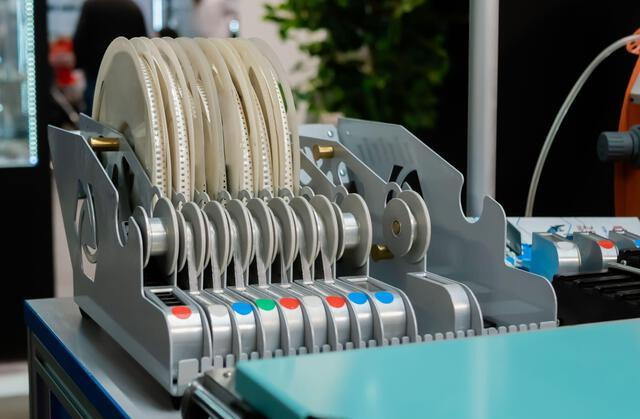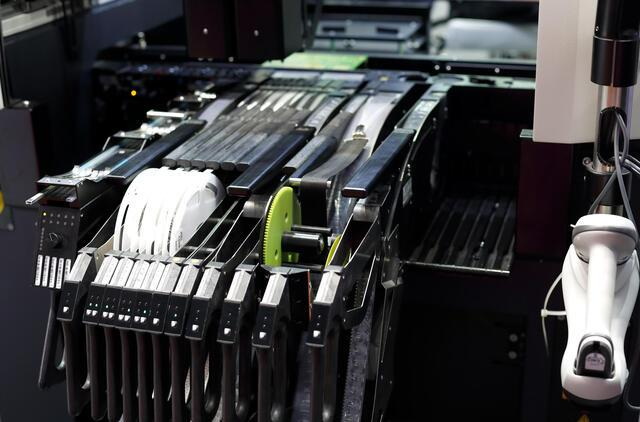Content Menu
● Understanding SMT Reels
● Key Features to Consider
>> Material Quality
>> Reel Dimensions
>> Component Compatibility
>> Carrier Tape Quality
>> ESD Protection
>> Storage Solutions
● Labeling and Identification
>> Automation Compatibility
● Additional Considerations
>> Cost Efficiency
>> Supplier Reliability
>> Compliance with Industry Standards
● Conclusion
● FAQs
>> 1. What materials are commonly used for SMT reels?
>> 2. How do I determine the right size SMT reel for my components?
>> 3. Why is ESD protection important in SMT manufacturing?
>> 4. What role does carrier tape play in SMT reels?
>> 5. How can automated storage solutions improve my SMT operations?
● Citations:
Surface Mount Technology (SMT) reels are essential components in the electronic manufacturing industry, facilitating the storage and dispensing of surface mount devices (SMDs) during the assembly process. Understanding the key features of high-quality SMT reels can greatly enhance production efficiency and reduce errors. This article will delve deeper into these features, providing a comprehensive guide for manufacturers looking to optimize their operations.

Understanding SMT Reels
SMT reels are designed to hold and dispense various electronic components, including resistors, capacitors, and integrated circuits. The design of these reels ensures that components are stored securely while allowing for easy dispensing during the assembly process.
The advantages of using SMT reels include:
- Compactness: SMT components are typically smaller than traditional through-hole components, allowing for more efficient use of space on PCBs.
- Higher Component Density: SMT enables a greater number of components to be placed in a smaller area, which is crucial for modern electronic devices that demand high functionality in compact designs.
- Faster Manufacturing Processes: The assembly process is generally quicker with SMT as components are directly placed on the PCB without the need for drilling holes.
- Increased Accuracy: Automated pick-and-place machines can place components with high precision, reducing the likelihood of errors.
- Cost Efficiency: The reduction in labor and material costs associated with SMT manufacturing can lead to lower overall production expenses.
Key Features to Consider
When evaluating SMT reels, manufacturers should focus on several critical features:
Material Quality
The material used for SMT reels significantly impacts their durability and performance. High-quality reels are often made from:
- Polystyrene (PS): Known for its strength and lightweight properties, making it ideal for reel construction.
- ESD-Safe Materials: Essential for protecting sensitive electronic components from electrostatic discharge damage.
Choosing reels made from robust materials helps prevent breakage and ensures that components remain protected during storage and transport.
Reel Dimensions
The dimensions of SMT reels must align with the specifications of the pick-and-place machines being used. Key dimensions include:
- Reel Diameter: Common sizes range from 7 inches to 13 inches.
- Reel Width: Should accommodate the size of the components being stored.
- Reel Hole Size: The central hole must fit securely on the feeding mechanism of the assembly equipment.
Proper sizing ensures smooth operation during component dispensing, minimizing downtime caused by equipment adjustments.
Component Compatibility
Different SMT reels are designed to hold specific types of components. Manufacturers should ensure that the reel they choose is compatible with:
- Component Size and Shape: Smaller components may require narrower tape widths, while larger components may need wider tapes.
- Type of Components: Some reels are optimized for specific component types, such as capacitors or ICs.
Understanding component compatibility helps avoid assembly errors and reduces waste, ultimately leading to more efficient production processes.
Carrier Tape Quality
The carrier tape is an integral part of SMT reels, as it holds the components in place. Key attributes to consider include:
- Thickness and Material: Thicker tapes provide better support for heavier components, ensuring they do not sag or misalign during transport.
- Adhesive Properties: The tape should securely hold components without damaging them during removal. High-quality adhesive ensures that components remain in place until they are ready to be picked by automated machinery.
High-quality carrier tape minimizes the risk of component misalignment during placement, enhancing overall assembly accuracy.
ESD Protection
Electrostatic discharge can severely damage sensitive electronic components. Therefore, it is crucial that SMT reels provide adequate ESD protection through:
- Conductive Materials: Utilizing materials that dissipate static electricity effectively protects sensitive components from damage.
- Proper Storage Conditions: Ensuring that storage environments are controlled to minimize static buildup is vital for maintaining component integrity.
Implementing ESD protection measures helps maintain component integrity throughout the manufacturing process, reducing costly defects and rework.
Storage Solutions
Efficient storage solutions for SMT reels can enhance overall operational efficiency. Features to look for include:
- Vertical Storage Options: These maximize space usage, allowing for more efficient organization of reels within limited floor space.
- Climate Control Systems: Maintaining optimal temperature and humidity levels prevents moisture damage to sensitive electronic components.
Effective storage solutions contribute to a streamlined workflow and reduced handling times, ultimately improving productivity on the assembly line.

Labeling and Identification
Clear labeling is essential for quick identification and retrieval of SMT reels during assembly processes. Features to consider include:
- Color-Coded Labels: Different colors can indicate various component types or specifications, facilitating easier identification at a glance.
- Barcoding Systems: Implementing barcodes allows for easy scanning and inventory management, reducing time spent searching for specific reels.
Proper labeling enhances organization and minimizes errors during production, leading to smoother operations and improved efficiency.
Automation Compatibility
As manufacturing processes become increasingly automated, ensuring that SMT reels are compatible with automated systems is vital. This includes:
- Integration with Inventory Management Software: Enables real-time tracking of reel usage and stock levels, helping manufacturers manage resources efficiently.
- Compatibility with Automated Storage Systems: Facilitates efficient retrieval and storage processes, reducing manual handling time and increasing throughput rates.
Automation compatibility can significantly improve production efficiency and reduce labor costs, making it an essential feature for modern manufacturing environments.
Additional Considerations
In addition to the core features discussed above, there are other considerations that manufacturers should keep in mind when selecting high-quality SMT reels:
Cost Efficiency
While investing in high-quality SMT reels may involve higher upfront costs, it is essential to consider long-term savings associated with reduced errors, improved efficiency, and lower rework rates. A thorough cost-benefit analysis can help manufacturers determine the most suitable options based on their operational needs.
Supplier Reliability
Choosing a reliable supplier is crucial when sourcing SMT reels. Manufacturers should assess potential suppliers based on their reputation, product quality, customer service, and delivery capabilities. Establishing strong relationships with suppliers can lead to better pricing agreements and improved access to high-quality materials.
Compliance with Industry Standards
Ensuring that SMT reels comply with relevant industry standards is vital for maintaining quality control throughout the manufacturing process. Compliance with standards such as IPC/JEDEC J-STD-020 ensures that materials used in reel construction meet safety requirements and performance expectations.
Conclusion
Selecting high-quality SMT reels is essential for ensuring efficient and reliable electronic assembly processes. By focusing on material quality, reel dimensions, component compatibility, carrier tape quality, ESD protection, storage solutions, labeling systems, automation compatibility, cost efficiency, supplier reliability, and compliance with industry standards, manufacturers can optimize their operations and reduce errors associated with component placement.
Investing in high-quality SMT reels not only enhances productivity but also contributes to the overall quality of electronic products. As technology continues to evolve within the electronics manufacturing industry, staying informed about advancements in reel design and functionality will be crucial for maintaining a competitive edge.

FAQs
1. What materials are commonly used for SMT reels?
SMT reels are typically made from polystyrene (PS) plastic or cardboard, with some variations using ESD-safe materials to protect sensitive components from electrostatic discharge.
2. How do I determine the right size SMT reel for my components?
The right size reel depends on the dimensions of your components as well as compatibility with your pick-and-place machines. Common reel diameters range from 7 inches to 13 inches.
3. Why is ESD protection important in SMT manufacturing?
ESD protection is crucial because electrostatic discharge can damage sensitive electronic components during handling and assembly, leading to costly defects or failures in finished products.
4. What role does carrier tape play in SMT reels?
Carrier tape holds components securely in place on the reel while allowing them to be easily dispensed during assembly. The quality of carrier tape affects both component protection and placement accuracy.
5. How can automated storage solutions improve my SMT operations?
Automated storage solutions enhance efficiency by providing quick access to materials, real-time inventory tracking, and optimized space usage which reduces labor costs and improves workflow efficiency.
Citations:
[1] https://global.neotel.tech/2023/01/05/what-is-smt-reel-storage-solution/
[2] https://www.southwestsolutions.com/ssg/material-handling/smt-reel-storage-solutions/
[3] https://global.neotel.tech/2022/02/24/5-things-you-must-know-about-smt-reel/
[4] https://www.analog.com/media/en/package-pcb-resources/package/tape-reel-rev-o.pdf
[5] https://www.adoptsmt.com/en/efficiency-enhancement-in-smt-manufacturing/
[6] https://www.forceone-am.com/en/a-SMT_what%20is%20SMT%20and%20SMD.html
[7] https://en.wikipedia.org/wiki/Surface-mount_technology
[8] https://electronics.stackexchange.com/questions/699703/what-should-be-the-minimum-number-of-smd-components-on-a-reel-minimum-tape-leng
[9] https://www.onsemi.com/pub/collateral/brd8011-d.pdf
[10] https://www.epsprogramming.com/blog/reduce-production-time-by-utilizing-tape-and-reel




















